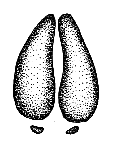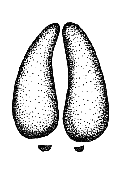
Deer
Ococoileus virginianus (whitetail) or Odocoileus
hemionus (blacktail or mule deer)
Description
- A tan or reddish-brown in the summer and greyish-brown
in the winter, the belly, throat, nose band, eye ring
and insides of the ears are white. There are black spots
on the sides of the chin. The antlers have individual
tines that grow upward from each of the main beams.
Distribution
- The mule deer has the widest distribution of the deer
found in British Columbia, occurring as far north as
the Liard River Valley and throughout the interior as
far west as the coast mountains. The whitetail deer
resides in the lower south-east corner of the province.
Found only in BC is the Northwest Whitetail deer.
Biology
- Deer are browsers rather than grazers and feed
on a variety of vegetation including green plants, nuts
and corn, and trees and twigs. Although the deer is
a good swimmer and runner (reaching speeds of 35 mph)
it falls prey to a number of animals including the cougar,
domestic dog, wolf, coyote, lynx, bobcat and bear. Once
this species was endangered but it is now more abundant
than ever.
Tracks - The mule deer has a distinct "bound"
in which all four feet come down together as if on springs.
The tracks will vary from a rough "V-shape" while running
to a straight line with slower speeds. The track varies
according to the surrounding landscape. In soft, woodland
areas the print is more pointed and on harder ground
where the hoof may be worn, the track may appear with
a blunter tip. The hoof print may be described as two
paisley shapes facing one another with smaller "dots"
of the dew claws at the wider end of these paisleys.


Straddle: 15.5 cm (6.2 in)
Stride: 50 - 61 cm (20 - 24.4 in)
Track: 8.5 cm (3.4 in) long / 6.5 cm (2.6 in) wide
The key difference in distinguishing the gallop of the
white-tailed and mule deer is while the mule tends to
bound as if on springs, the white-tailed deer "rocks"
by swinging its hind feet ahead of the front ones. The
white-tailed deer is known to drag its hooves between
steps creating troughs between each print. The hoof
print itself is nearly indistinguishable from that of
the mule deer.
Straddle: 15.5 cm (6.2 in)
Stride: 33 - 50 cm (13.2 - 20 in)
Track: 7 - 9 cm (2.8 - 3.6 in) / 4.5 - 6.5 cm (1.8 -
2.6 in)



